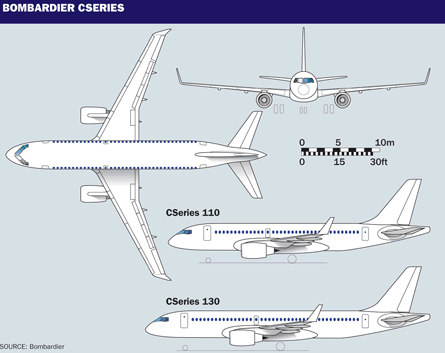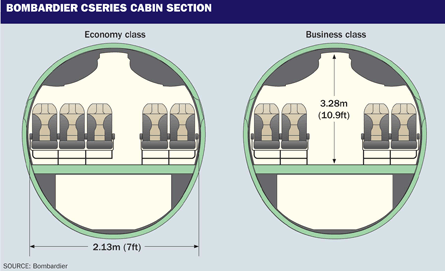If the demise of Eos, Maxjet and Silverjet sounded the death knell for the all-premium airline concept, it has not been heard by Bombardier. The Canadian airframer believes there is a small but profitable market for an all-business-class CSeries cabin and is working with interiors specialist and CSeries supplier C&D Zodiac to explore low-density configurations for the Pratt & Whitney PW1000G geared-turbofan-powered narrowbody.
"Several airlines are talking about using the CSeries in this way," Bombardier commercial aircraft president Gary Scott told Flight International at last month's Dubai air show. "It's not a large quantity of airplanes. It's not a large market, but it is very lucrative."
In standard iteration, the five-abreast 100- to 125-seat CSeries CS100 and larger 120- to 145-seat CS300 will accommodate 47cm (18.5in) window and aisle seating, and a bigger, 48.25cm (19in) middle seat.
 |
|---|
© Bombardier/Flightglobal |
"We optimised around five-abreast, but we built an airplane that's basically half a seat larger than the current five-abreast airplanes," says Scott, referring to the McDonnell Douglas DC-9, MD-80 and Boeing 717. "We are able to put these bigger seats in and put in a bigger aisle to give added comfort."
Making the CSeries cabin a crucial half-seat narrower than six-abreast aircraft "was a conscious decision that allowed us to be 10,000lb [4,535.9kg] lighter than [similar-sized] Boeing/Airbus products and we wanted to reap that advantage", says Scott. At the same time, it allowed Bombardier to offer a cabin better suited to all-premium configurations than six-abreast Airbus or Boeing narrowbodies which have "wasted space", he adds.
Bombardier has not yet detailed the premium seating arrangements being considered.
British Airways famously launched a transatlantic Airbus A318 service between London City and New York JFK in October. The 32-seat A318 makes a fuel stop at Shannon, Ireland on the westbound leg because the short runway at London City cannot accommodate an A318 with full fuel. Bombardier's CS100 is expected to be certified for London City.
But BA, which also operates the premium transatlantic OpenSkies brand, is by no means the only carrier to target the all-business market. CSeries customer Lufthansa's so-called "Lufthansa Business Jet" service is flown by Swiss operator PrivatAir and currently serves a number of routes with narrowbody aircraft, including the Frankfurt-Pune, India city pair.
Pune, a centre for the information technology, biochemistry and automotive industries, is fuelled by "demand from corporations" and is the type of market Bombardier should bank on for an all-premium CSeries, says Shashank Nigam, chief executive of global airline marketing and branding consultancy Simpliflying.
He suggests, for example, that Canadian start-up Enerjet "would be a very good client for an all-business-class offering by Bombardier". Enerjet mainly operates charters for Calgary-based Suncor Energy and Sands, which in late 2008 awarded the carrier a multi-year contract to shuttle its workers to oil sand development sites in remote parts of northern Canada.
The Boeing 737-700 operator "is flying to a lot of destinations where Air Canada does not operate, and this is where all the oil sands are being found", says Nigam, adding: "Merging the private jet concept, which represents niche demand, with sustained demand makes the all-premium CSeries concept feasible."
 |
|---|
Bombardier is also confident the CSeries will attract budget and start-up carriers. Many of the major airlines in the Middle East region, for instance, are looking to expand their regional network, says Scott. "That is bringing a lot of interest to Bombardier."
But the airframer is not seeing an overwhelming push for ultra-high-density CSeries configurations from potential customers. "If anything, we're seeing trends that airlines are starting to maybe compete a little bit again on passenger comfort, with customers talking about new configurations," says Ben Boehm, Bombardier vice-president commercial aircraft programmes.
 |
|---|
The airframer's seemingly minor decision to widen the middle seat could make an important impact on how passengers perceive the CSeries cabin.
"Passenger uneasiness is not generated by the people in front of you, separated by a wall of seat-backs, or to the back of you," says air transport consultant Morten Müller. "Uneasiness is generated by the lateral closeness of the person who is actually going to touch you, so the conclusion of some analysts and experts is that it makes no sense to give pitch to people. What you need is lateral freedom of space."
The current five-abreast aircraft were built in the 1960s, says Scott, "so we're building for the 2020 to 2060 time period". Bombardier is planning to have the CS100 enter service in 2013.
BOMBARDIER PLANS UNPRECEDENTED PRODUCTION RATE FOR CSERIES
Gary Scott, president of Bombardier commercial aircraft, says the 65,000m2 (700,000ft2) factory that currently supports production of the CRJ700, CRJ900 and CRJ1000 aircraft will be expanded by just under 92,900m2 for the CSeries.
The greatly extended Mirabel facility will be able to produce one aircraft every manufacturing day or 20 CSeries aircraft a month by 2016 - three years after the CS100 enters service.
"We're planning, and have all of our suppliers committed to, a day rate," says Scott. "So we will be prepared to go as high as a day rate, because we think we'll need to, so 20 airplanes a month. Can we go higher? Sure. It'll just take additional investment, but clearly it is going to need a significant production rate."
Bombardier's ambitious production plans for its new narrowbody 100- to 125-seat CS100 and 120- to 149-seat CS300 follow similar unprecedented production rate forecasts by Boeing and Airbus to meet customer demand for its next-generation widebodies.
 |
|---|
© BombardierMirabel facility will more than double in size |
A one-day rate for the CSeries would represent the highest-rate production programme in Bombardier's history. At the height of its production, the CRJ200 reached only a one-and-a-half-day rate or 12-13 a month, and current CRJ production stands at a three-day rate.
Scott says Bombardier plans to build as many as 3,000 CSeries aircraft over the next 20 years. The Mirabel facility will be expanded in phases, the first of which is under way as Bombardier builds the Complete Integrated Aircraft Systems Test Area (CIASTA) for CSeries testing and proving aircraft systems a full year before the first flight of the CS100 in 2012.
The second phase will see construction of supplier support and aircraft integration facilities, says Scott.
Calling the Mirabel expansion a "supersite" is a misnomer, he says, because the globally distributed supply chain will see major portions of the aircraft, such as the wings and centre fuselage, built in Belfast, Ireland and Shenyang, China, respectively.
One such supplier facility will be established by Pratt & Whitney for final engine build-up, enabling delivery of a "fully podded" PW1500G engine along with a Spirit AeroSystems-built pylon from a facility adjacent to Mirabel final assembly, says Scott.
One integration facility will support build-up of the wing box, after it arrives partially integrated from the company's Belfast division. Bombardier announced on 17 November that it had begun construction on its 55,750m2 $860 million factory in Northern Ireland.
The third phase of the programme will see the construction of the CSeries final assembly line and, later, paint and delivery facilities.
"We have gone all the way from more of a static assembly process," says Scott of Bombardier's current production model. "On many of our current production programmes, we are moving towards a moving line as well, so we embrace the idea of a moving line, but you need to mature your processes and so, initially, CSeries final assembly will be a pulse line, but with the objective of going to a moving line."
The Mirabel growth was first seen as a 111,500m2 expansion, but it was revised downward to less than 93,000m2 by integrating the CSeries infrastructure with the existing regional jet production.
"The expansion is still rather significant," says Scott. "We're going to more than double the Mirabel facility. When we first looked at the CSeries, we looked at it more as an adjacent facility to the regional jet facility."
Scott says that as Bombardier "thought through it more", it began to "look for opportunities to integrate it better with the existing regional jet production [at Mirabel]".
Using the existing CRJ administrative facilities as a base to support expansion for CSeries rather than a completely new administration support building for the new aircraft is "an obvious way to reduce our cost and our footprint", he says.
Scott says Bombardier continues to review the final factory plans for the CSeries in Mirabel.
The company currently holds firm orders for 50 CSeries aircraft from Lufthansa and lessor LCI.
Source: Flight International



















